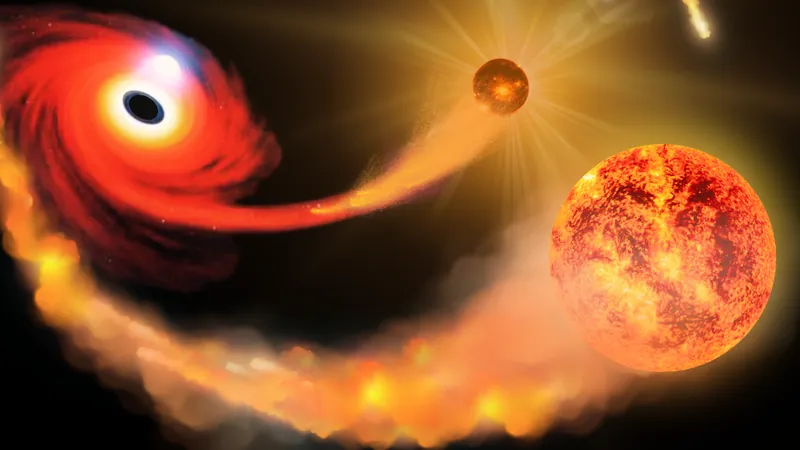
Star Makes a Daring Escape from Insatiable Supermassive Black Hole, Leaving its Companion Behind!
2025-01-10
Author: Wei
Groundbreaking Observation of ASASSN-22ci
Astronomers have made a groundbreaking observation of a supermassive black hole that showcased a remarkable double-flash Tidal Disruption Event (TDE), a rare and powerful cosmic phenomenon. This event, known as ASASSN-22ci, perhaps involved a black hole snagging a binary star system—devouring one star while the other made a thrilling escape!
Understanding Tidal Disruption Events (TDEs)
TDEs are astronomical occurrences where a massive black hole rips apart a star that strays too close, releasing energy detectable from billions of light-years away. What's astonishing about ASASSN-22ci is not just its rarity, but also the unusual frequency of its twin flares—an occurrence observed in only a handful of similar events so far. The supermassive black hole responsible for ASASSN-22ci is located about 408 million light-years from Earth in the galaxy WISEA J122045.05+493304.7.
The Significance of the Double Flare
According to lead researcher Jason Hinkle from the University of Hawaii, the double flare's unique quality lies in its seemingly "normal" characteristics: "The light curve and spectra of ASASSN-22ci are considered to be some of the most typical among TDEs displaying multiple flares." With its first flash detected in February 2022, researchers initially considered it just another standard TDE. However, the unexpected resurgence of light from ASASSN-22ci almost two years later generated excitement and intrigue among astronomers.
The Mechanism Behind Double TDEs
The reason behind these double TDEs remains elusive, but scientists suspect the mechanism might be linked to what is known as "Hills capture." This phenomenon occurs when a binary star system travels close to a supermassive black hole, resulting in one star being flung away at high velocity while the other remains nearby, susceptible to further disruptions and possible repeated flares.
Gravitational Forces and Spaghettification
The nature of these tidal forces, stemming from the immense gravitational field of the black hole, causes the unfortunate stars to undergo a repulsive stretching effect dubbed "spaghettification." This process transforms stars into elongated streams of plasma that eventually feed into the black hole's accretion disk. Hinkle explains the ongoing saga: "If the captured star crosses into the black hole’s tidal radius, each encounter can reignite a new flare until it is wholly consumed."
Looking Ahead: Potential Third Flare
Excitingly, researchers predict that a third flare from ASASSN-22ci may occur in early 2026. Following the observed 720-day cycle between the first two flashes, astronomers are preparing for further observations during this anticipated event. If the third flare does occur, it could lead to unprecedented insights into the physics of TDEs.
Uncertain Outcomes and Future Observations
Yet, the outcome remains uncertain. Should the star be fully disrupted by the second flare, or could the two previous flares stem from independent TDEs? The predictions for the next flare provide researchers the opportunity to observe and study the initial phases of the TDE as it unfolds—a feat not typically possible with random TDE occurrences.
Conclusion: A Cosmic Drama Unfolds
As the astronomical community gears up for potential groundbreaking revelations, eyes will be on ASASSN-22ci as it possibly stages its third act in this cosmic drama. Will the supermassive black hole reveal even more secrets? Only time will tell!


 Brasil (PT)
Brasil (PT)
 Canada (EN)
Canada (EN)
 Chile (ES)
Chile (ES)
 Česko (CS)
Česko (CS)
 대한민국 (KO)
대한민국 (KO)
 España (ES)
España (ES)
 France (FR)
France (FR)
 Hong Kong (EN)
Hong Kong (EN)
 Italia (IT)
Italia (IT)
 日本 (JA)
日本 (JA)
 Magyarország (HU)
Magyarország (HU)
 Norge (NO)
Norge (NO)
 Polska (PL)
Polska (PL)
 Schweiz (DE)
Schweiz (DE)
 Singapore (EN)
Singapore (EN)
 Sverige (SV)
Sverige (SV)
 Suomi (FI)
Suomi (FI)
 Türkiye (TR)
Türkiye (TR)
 الإمارات العربية المتحدة (AR)
الإمارات العربية المتحدة (AR)